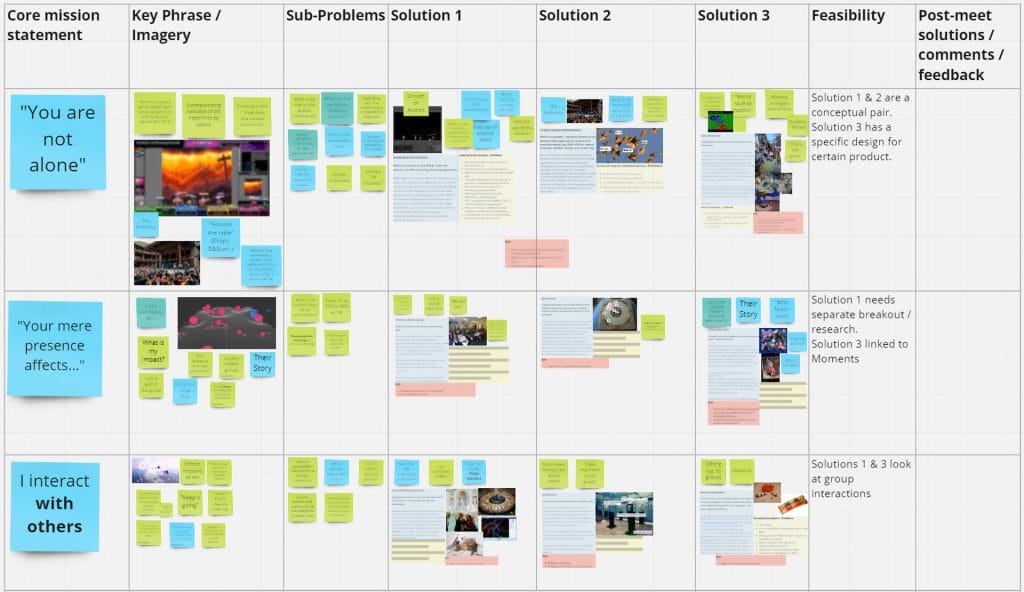Welcome to the 2nd article in this mini-series around Ideation in MILEs!
(Article #1 available here – Ideation in MILES: What to Look for – Genvid Technologies)
We are going to discuss a few different approaches you can take for the ideation process. One of the first questions to ask is whether this is a group or solo process?
- As the sole responsible creative, you can approach this process solo. Please use caution however – new spaces tend to require an approach from multiple types of personalities. It is recommended to invite a group into the process for at least the initial brainstorm or at the very least discuss with peers if you can.
- As a group (or even a smaller team), we aim more for consensus. Implement at the end a priority / decision making process (this can be a person, an agreement on prototype building to check for validation,etc).
The rest of the article will explore the group process approach, with a lead person taking responsibility. It’s best to have the ideation process have a lead or product owner – this can be purely solo or with 2-3 persons that make sure the process is completed from start to finish. The largest advantage of having 2 persons leading is that it ensures work on ideation progresses irrespective of other attendee schedules.
A quick incomplete list of people within the ideation process for reference:
- Lead(s) – this person is responsible for arranging sessions, making sure the documentation, communication and summaries are made and shared as needed.
- Attendees, broken into two groups:
- Solicited Attendees – if discussing specific topics, you may solicit subject matter experts that can aid in defining parameters and solution viability
- General Attendees – these are guests that respond to an open call, often for the initial brainstorm. Input is ad hoc but still worth welcoming to allow a diverse set of backgrounds and viewpoints.
- Testers – People that will react to the solutions from ideation. These can be internal or external, with or without context as needed.
Let’s start with radial brainstorming – you take a central concept, break it down into its component parts and then fill it outwards with additional write-ins around these concepts. These write-ins can be key phrases, problems to consider, concepts, images, videos, solutions, etc.
Depending on the volume, you can then choose how much time you want to spend tackling the results. This may take quite a bit of time and effort but again, it remains vastly cheaper than expensively building an ill-fitted solution requiring at best to change construction mid-way and at worst to have a non-functional or low quality product. Normally, the initial brainstorm can be done even on large topics within an hour or two, whereas base exploration per sub-topic takes up to a few hours at least.

Breaking into components is usually something best reserved for the people leading the brainstorming to help invitees give their concepts within more set parameters. However, attendees can absolutely expand the components into new areas – part of the process is making sure different perspectives chime in, irrespective of level!
If you wanted to avoid a large synchronized Brainstorming meeting, you could also do it via a written listed method instead. Similar to the above, solicit content from attendees in a list format that each of them does on their own. This method is well suited if you are seeking to solve a single concept and your company has a good digital documentation culture.
Once the brainstorming is done, collect the content from each section and set it aside. Whatever brainstorming you do to support your ideation process, do not discard ideas yet – this is done in a future step.

Try dividing the content into the following:
- A Core Mission Statement – this can be a key phrase, a core motivation or sentiment, with the aim of encapsulating the topic you are trying to solve for.
- Key Phrases / Imagery – add here all the additional material that supports your Core Mission Statement, that offers pathways and possibilities. Make sure it’s not just text as audiovisual materials communicate quite strongly.
- Sub-problems – set here the problems you are trying to solve for within this Core Mission Statement, concepts that are antagonistic to the goal, concerns the team may have, blockers towards execution.
- At this point, you can cut materials that don’t fit into the above from the process as discards from the brainstorm.
And finally, proposed solutions:
- Build solution pathways around your Core Mission Statement – you can go from a key phrase, a sub-problem or a combination of a few of these.
- Aim to find 3 potential solutions; If you have limited time / scope, do this for the Core Mission Statement, but if you have lots of time, you can do this per pathway.
- From there, evaluate the solutions in terms of next steps. Abandoning a pathway at this stage is acceptable if you feel that the best proposed solution is inadequate to develop further but there aren’t better or feasible ones on offer.
The above can be split as you see fit. For example, communal collaboration to set the Core Mission Statement, the key phrases and subproblems is done together, with people breaking off to find proposed solutions in assigned sections; the group then reconvenes to discuss these.
One possible way to deviate is to set the Core Mission Statement prior to the brainstorming, particularly useful if the ideation process is to find a solution to a narrow-scope problem that the team is well aware of; jumping ahead likely will save time and energy.
To recap, here is what a potential ideation process timeline may look like:
- Initial Brainstorm (all)
- Division into subtopics:
- A number of sessions per sub-topic, depending on complexity and volume
- Specific stakeholders have an invite to attend discussion on each sub-topic
- Highlight findings (including dead-ends) and recommended actions to take
- Clean-up after discussing sub-topics
- Invite stakeholders to recap findings and decide prioritization once all Core Mission Statements have been explored (eg. move to prototyping, concept for another product, do not follow-up with, etc.)
A final word of caution – the above is one way, among others, to do the ideation process; you may find more success with alternatives. The fundamental, most important aspect is that people care about the team succeeding and are willing to step out of their comfort zone to help in solving complex problems.
As a note – there are a ton of brainstorming methodologies out there, the above being mostly a personal selection. A basic starting point to look into other methods would be reading through this wiki article for inspiration.
We will look in the next article at practical exercises around the processes described above. Feel free to chat to us on our Discord Server in the meantime!
Article #3 available here – Ideation in MILEs: Practical Exercise – Genvid Technologies


